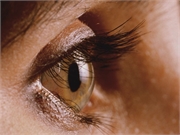'Smart' Contact Lenses Might Also Monitor Eye Health
By Alan MozesHealthDay Reporter

TUESDAY, Dec. 10, 2019 (HealthDay News) -- Eye doctors may someday use "smart" contact lenses to track patients' eye health, early research suggests.
A team of scientists in South Korea has packed incredibly small electronic circuitry, batteries and antennae into a soft contact lens. The goal: to monitor eyes for signs of vision trouble or help deliver medicinal eye treatments.
In what's called a "proof of concept" study, the researchers tested their experimental prototype on rabbits and one human.
The "smart contact lens is meant to correct vision and drive electronic devices," explained study author Sang-Young Lee.
In theory, such devices could continuously screen eye fluids for telltale signs of early eye disease, such as glaucoma, or illnesses such as diabetes, said Lee, a professor at Ulsan National Institute of Science and Technology.
Lee said the smart lens was crafted to be as small, soft and flexible as typical soft contacts without triggering eye irritation, heat discomfort or any reduction in field of view.
Using cutting-edge technology, the researchers enhanced the lens with a technique known as "direct ink writing."
This entails adding multiple layers of minute electrode circuitry to the contact's outer edge with an ultra-thin paste. The paste forms what Lee described as a "miniaturized energy storage system," also known as a "solid-state supercapacitor."
Such capacitors allow for wireless round-the-clock charging. They charge and power tiny "nano-fibers" stretched across the contact's edge.
The final product is neither bulky nor rigid and did not generate excess heat, said Lee. And the embedded circuitry functioned properly following up to a week of exposure to tear fluid.
But is it safe?
The rabbits and human volunteer wore the contact for 10 minutes "to demonstrate its wearability and functionality regarding the wireless charging system," Lee noted.
They "did not show any signs of discomfort, such as eye redness," he said. The test patient also reported no limitations on field of vision.
But team members acknowledged the limits of their safety assessment, noting that a large human trial has not yet been scheduled. That means their smart lens is a long way from becoming available to the public.
The current work was to see if the smart technology could be miniaturized, comfortable and functional.
One eye health expert said there's promise in this research.
"The idea of a smart contact lens has been explored quite a bit in the wearable device world," said Dr. Thomas Steinemann, a clinical spokesperson for the American Academy of Ophthalmology. "And with good reason. An effective electric contact lens able to detect changes in the eye in real time would hold a lot of potential in innovating the way we detect and prevent potentially blinding eye diseases."
Smart contacts, said Steinemann, might enable doctors to keep tabs on progressive eye diseases like glaucoma between in-person visits. And they may ultimately even help clinicians predict disease progression before it happens.
"[So] though the technology may not be there yet for wide usage, the promise of a safe and effective smart contact lens is very exciting," he said.
Looking ahead, Lee said the key objective would be to integrate such lenses with "sophisticated diagnostic sensors" able to spot signs of disease with high accuracy.
Findings from the new study are detailed in the Dec. 6 issue of Science Advances.
More information
There's more about the diagnostic potential of smart lenses at the American Academy of Ophthalmology.

The news stories provided in Health News and our Health-E News Newsletter are a service of the nationally syndicated HealthDay® news and information company. Stories refer to national trends and breaking health news, and are not necessarily indicative of or always supported by our facility and providers. This information is provided for informational and educational purposes only, and is not intended to be a substitute for medical advice, diagnosis, or treatment.

